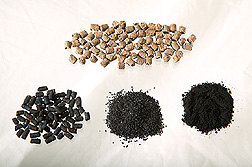This page has been archived and is being provided for reference purposes only. The page is no longer being updated, and therefore, links on the page may be invalid.
New Process for Making Activated Carbons Patented by ARS
By Rosalie Marion BlissJuly 22, 2009
Activated carbons, commonly produced from nonrenewable coal and from plant byproducts like wood and coconut shells, are used to purify liquids and gases, recover chemical pollutants, and clean up environmental contaminants. Now, the Agricultural Research Service (ARS) has been issued a patent on a new technology that uses renewable and inexpensive animal byproducts to produce activated carbons.
Chemist Isabel Lima and Wayne Marshall (now retired) at the ARS Southern Regional Research Center (SRRC) in New Orleans, La., developed the method for turning agricultural bio-waste into activated carbons. This material, called biochar, is the charred remains of poultry litter, supplied by poultry facility operators in the form of bedding materials made of sawdust, wood shavings, and peanut shells, as well as droppings and feathers.
U.S.-grown broiler chickens and turkeys produce an estimated 15 million tons of litter annually.
The process of turning the bio-waste into activated carbons involves grinding the waste materials into a fine powder that is subsequently pelletized. The material is then heated in an oxygen-free furnace at 1,300 to 1,500 degrees Fahrenheit, creating a completely sanitized product.
Poultry waste’s high phosphorous content may be considered a pollutant when large amounts of the phosphorus enter groundwater, rivers and streams via runoff. But the relatively high concentration of phosphorus adds a negative charge to the activated carbon that is ideal for attracting positively charged ions from metals such as cadmium, copper, zinc and lead.
The technology works when the highly porous and chemically active surfaces of the activated carbons come into contact with, and adsorb, pollutant molecules in gases and liquids.
Based on published preliminary estimates, the cost of producing the biochar would be about 65 cents per pound of broiler-litter-based carbon, which is competitive with commercial alternatives. Evaluations also have shown that the materials perform at least equal to or better than available carbon products on the market.
The activated carbons produced from animal byproducts may be utilized as adsorbents in any air or liquid waste stream cleanup application in which traditional activated carbon is used, according to the inventors.
ARS is the principal intramural scientific research agency of the U.S. Department of Agriculture.

